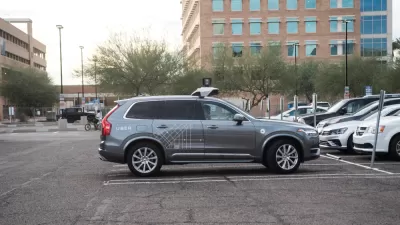At the dawn of automated vehicle technology, humans, and Americans in particular, should recall the shortcomings of past utopian visions.

William Leimenstoll notices a few similarities in the utopian visions of transportation technology boosters nearly a century ago with those of the current day. In fact, writes Leimenstoll, "[i]f you switch the publishing years and the technology named, many articles extolling the virtue of automated vehicles (AVs) would be remarkably indistinguishable from those supporting urban freeways decades ago."
The article details the marketing efforts that drove the popular and political support for the Interstate Highway System, as well as the unintended consequences of that epoch-defining infrastructure investment. While freeways made home ownership a reality for more Americans, they also eroded the economic and social fabric of central cities, for example. The current moment should inspire caution, according to Leimenstoll, not uncritical exuberance.
"Clearly, momentum for smarter, more sustainable communities is growing, but enthusiasm for AVs threatens to derail this success," writes Leimenstoll. "Without learning from the pitfalls of our eager embrace of urban highways, communities may make the same mistakes again."
So for instance, while automated vehicles might bring incredible benefits in traffic safety and congestion, it could also induce demand, increasing wear and tear on roads and negative environmental outcomes. With both sides of the spectrum of potential effects in mind, Leimenstoll concludes the article by suggesting some steps for planners to begin taking as soon as possible.
FULL STORY: An “Unprecedented Mobility Revolution?” We’ve Been Here Before

Planetizen Federal Action Tracker
A weekly monitor of how Trump’s orders and actions are impacting planners and planning in America.

San Francisco's School District Spent $105M To Build Affordable Housing for Teachers — And That's Just the Beginning
SFUSD joins a growing list of school districts using their land holdings to address housing affordability challenges faced by their own employees.

The Tiny, Adorable $7,000 Car Turning Japan Onto EVs
The single seat Mibot charges from a regular plug as quickly as an iPad, and is about half the price of an average EV.

As Trump Phases Out FEMA, Is It Time to Flee the Floodplains?
With less federal funding available for disaster relief efforts, the need to relocate at-risk communities is more urgent than ever.

With Protected Lanes, 460% More People Commute by Bike
For those needing more ammo, more data proving what we already knew is here.

In More Metros Than You’d Think, Suburbs are Now More Expensive Than the City
If you're moving to the burbs to save on square footage, data shows you should think again.
Urban Design for Planners 1: Software Tools
This six-course series explores essential urban design concepts using open source software and equips planners with the tools they need to participate fully in the urban design process.
Planning for Universal Design
Learn the tools for implementing Universal Design in planning regulations.
Smith Gee Studio
City of Charlotte
City of Camden Redevelopment Agency
City of Astoria
Transportation Research & Education Center (TREC) at Portland State University
US High Speed Rail Association
City of Camden Redevelopment Agency
Municipality of Princeton (NJ)





























